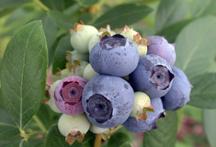Rabbiteye Blueberry cultivars are the primary species grown in the Panhandle and are much more popular than the Southern Highbush Blueberry that dominates production further south. Our environment is more hospitable to Rabbiteye; consequently, they tend to be more drought tolerant and less susceptible to disease. The harvest season for Rabbiteye Blueberries is also relatively long. Harvesting can extend from May to July, depending on cultivar selection.
Rabbiteye blueberry season starts to wrap up this month in the Panhandle, as late season cultivars begin their mature fruiting stage. This is also the time of year when we receive seemingly daily afternoon thunderstorms. These frequent rainfall events can compromise blueberry plants over the long term if good management measures are not in place.
One of the primary issues experienced with Rabbiteye Blueberry is Phytophthora Root Rot (PRR). This disease is a problem this time of year due to increased rain events and poor draining soils. PRR is caused by the fungus, Phytophthora cinnamomic. Infection by this fungus can lead to plant death if not managed; however, it is a condition that is easier to detect than most diseases. A clear sign of infection is the appearance of symptoms resembling fall color development in the foliage (leaves turning various shades of yellow, orange and red). Foliage color change is followed by leaf drop. A preventative fungicide can be used to treat this condition, but cultural methods (such as transplanting in well drained soils and using at least 3” of pine bark as mulch) will greatly reduce the risk of infection. Remember, blueberries, like azaleas and camellias are also acidic soil loving plants. Soils in the pH range of 4.0-5.5 are necessary for overall plant health and high fruit yields. Pine bark mulch, in addition to improving drainage and organic matter content, will assist in maintaining an acidic pH.
Botrytis Flower Blight or Gray Mold, caused by Botryospheria spp., is another potential issue experienced in late spring/early summer due to lingering moisture. To prevent Botrytis, avoid any overhead watering during the budding and flowering stage or keep watering to the early morning hours so moisture doesn’t linger overnight. Stem Blight can also occur this time of year. Symptoms of Stem Blight are of dying branches, which should simply be removed with sharp shears. There is no chemical control for stem blight and the best defense against this condition is good cultural practices that will in turn reduce plant stress.
In addition to potential fungal diseases, increased summer temperatures and rainfall often also bring an increase in insect populations. Most insecticides that are safe for ornamental landscape plants and fruit crops are safe for blueberries, just be sure to check the label for application rates, directions and precautions. Also, pay close attention to the label for the HI or harvest interval. This is the number of hours or days that need to pass before you can safely harvest fruit once an application of insecticide is made.
For more information on growing blueberries, please contact your local county extension office.
Supporting information for this article can be found in the UF/IFAS EDIS publication, “2017 Florida Blueberry Integrated Pest Management”, by Jeffrey G. Williamson, Phillip F. Harmon, Oscar E. Liburd & Peter Dittmar: http://edis.ifas.ufl.edu/pdffiles/HS/HS38000.pdf
& “Blueberry Gardener’s Guide”, by J. G. Williamson, P. M. Lyrene, and J. W. Olmstead: http://edis.ifas.ufl.edu/pdffiles/MG/MG35900.pdf
UF/IFAS Extension is an Equal Opportunity Institution.
- The Sunshine State is the Perfect Place for Sunflowers - July 20, 2025
- Why Are Sand Dunes & Sea Oats So Important? - March 20, 2025
- How to Care for a Gift Plant - December 5, 2024

